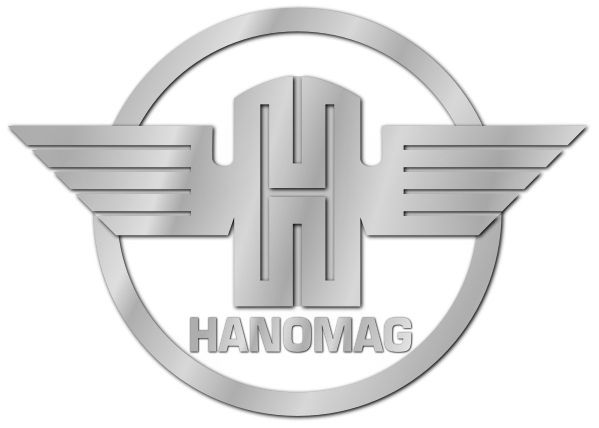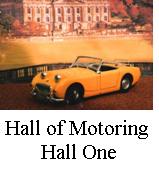
1924 Hanomag 2/10 PS 'Kommissbrot'
The ‘Hanomag’ name can be traced back to the Eisen-Giesserei und Maschinenfabrik Hannover established by Georg Egestorff in 1835. This company built small steam engines but soon diversified into farm machinery. Egestorff took his expanding company into railway locomotive production, the first being manufactured for the Hannover State Railway in 1846; business went well, in 1870 the works turned out 500 locomotives.
In 1871 the company name was changed to Hannoversche Maschinenbau AG with the abbreviation “Hanomag” quickly becoming an established name in the transport engineering world. Further growth saw the company producing and a range of tractors and winning a contract for steam lorries for the German army in 1905.
By 1912 petrol engined vehicles were being manufactured too and the future looked bright for the Hannover based company; then came World War One.
After the great war “Hanomag” was facing tough times with a serious decline in steam vehicles and even the locomotive market was in decline. In the early 1920s Hanomag decided to move into the motor car market to boost their income, particularly the small economy cars that were affordable to a large section of the working public.
Engineers Fidelis Böhler, Karl Pollich and Hellmuth Butenuth worked on a design to meet the companies stated requirements and they put a great deal of consideration into the construction and layout of the vehicle. What they produced was probably the smallest, and simplest, car of it's time, a design to which the word minimalist can rightly be applied.
The 2/10 PS, that is to say 2/10 horsepower (2hp rating for car tax purposes and 10hp actual power output) was named Zweisitzer Limousine, or two seat passenger car. It was the first car to be produced with the wheels enclosed within the body work, with no running boards or 'fenders' distinguishable. This design, the so-called pontoon body, was a result of the layout of the wheels and engine. With wheels set right out to the corners (much like the later Mini design) there was more room for the passengers to sit comfortable side by side with no leg room constraints. The floor could be kept low, again aiding comfortable seating positions and easy access to the car.
The single cylinder 500cc engine was mounted in the rear low down ahead of the rear axle. Drive to the rear axle, which had no differential, was by chains. This compact drivetrain was another factor in allowing the overall floor level to be lower and the cabin space maximised. The engine was a single-cylinder water cooled engine unit with a very low friction rating. This, coupled to the very light weight of the body (370kg or 816lb), gave the car impressive fuel consumption figures of 4ltrs per 100km (that's 71mpg); the world's most fuel efficient mass-production car of it's era.
The front suspension was of an independent nature facilitated by transverse leaf springs, the rear rear beam axle had coil springs. Only one brake drum was fitted to the car, this being a contracting band type on the rear axle. A three speed manual gearbox enabled the vehicle to make 60kph, or 40mph.
The unusual shape of the body was accentuated by the single headlight in the centre making this vehicle stand out from others using the roads at the time. It also earned the car is nickname of the “Kommissbrot” (army loaf) as it looked a lot like the loaves of Rye bread cooked by the German military to feed it's troops.
The Hanomag 2/10 PS was sold as the coupe, a cabriolet and even a delivery van version. Between 1924 and 1928 15,775 units were produced making “Kommissbrot” the most successful German "people's car" before the Volkswagen era. Competitors to the Hanomag were Opel's Laubfrosch and later the BMW Dixi DA1 (a left hand version of Austin Seven), the later being significant in that it had four seats and was much cheaper than the Kommissbrot.
Despite the high sales the vehicle made little profit for Hanomag an hard times were to be endured in the coming years. In the late 1920s the company sold off it's locomotive division to Henschel & Son of Kassel and concentrated on diesel engined tractors and the more conventional 3/16PS passenger car. The stock market crash and subsequent depression hurt Hanomag but they were able to capture 14% of the German home market, 2nd only to Opel. Then the banks called in company's loans and the financial crisis led the works being remortgaged to Hannover City and the Vereinigte Stahlwerke trust. This also caused a change of company name to Hanomag Automobil und Schlepperbau GmbH. They continued to make small cars like the 1.1ltr “Garant” in 1934 and the 1.5ltr “Rekord”, a diesel version of which was shown at the 1936 Berlin Motor Show.
During World War II had the inevitable change to military vehicle production in co-operation with both BMW and Stoewer. After the war Hanomag return to production of tractors and trucks. But little by little Hannomag was sold off and merged with other companies until the name was lost to the mists of history.
Legacy
The little Hanomag was years ahead of it's time in having it's engine mounted almost mid-ships and being of pontoon body. Auto Union GP cars used this engine lay out very successfully as did Mercedes with their 150 Sport Roadster. In post war United States Kaiser-Frazer rediscovered the pontoon body style and were the leading proponents of the body style in the Americas.
An interesting aside
Hellmuth Butenuth rose to technical director at Hanomag by the late 1920s and he used Hanomag 2/10PS chassis in motor racing pursuits. Stripped of their bodywork, which was replaced by canvas panels to protect the driver a little, one of the cars drove the 12 laps or 340.8 km of the Nürburgring's in a race on the 19th of June 1927. Butenuth's time for the race was 5h36m19.4s. He went on to win 500cc class in another race in 1927 too.









Rod built this model in early 2017, entirely by hand from scratch. It is made from plasticard and Evergreen rod and strip. The three body parts can be removed from the chassis to show the simplicity and details.
The model is painted with Halfords acrylic grey primer from a rattle can. Body colout is from the Americana range of acrylic paints applied through an airbrush. Halfords car spray paint clear lacquer was then applied all over the paintwork.
